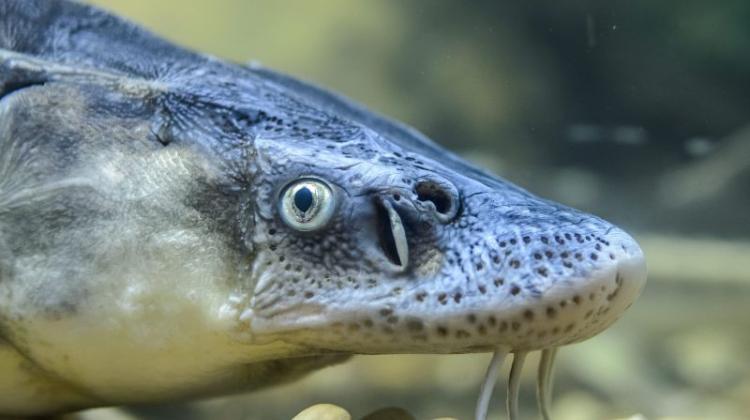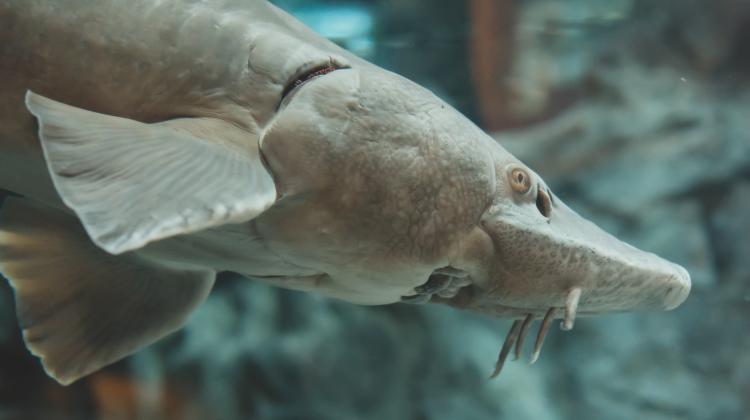Restoration of the sturgeon population in the Polish rivers brings results
 Photo: PAP 2015 / Wojciech Pacewicz
Photo: PAP 2015 / Wojciech Pacewicz
Restoration of sturgeon in Polish waters based on artificial fry farming has continued for several years. More than PLN 6.5 million have been spent on this purpose. In 2013, 440 tons of fish were produced. 40 fish farms want to take up sturgeon breeding.
Sturgeons are highly appreciated by gourmets. Not only because of the tasty meat, but also because of their eggs. The most valued is black caviar from the Caspian Sea sturgeon.
Sturgeon population was once large in the Baltic Sea. However, intensive fishing and pollution have led to a huge decrease in numbers of the fish. At the beginning of the twentieth century, the decline in their numbers was so large that sturgeon fishing lost economic importance and bans on fishing for this species were introduced (in Poland partial in 1932, full ban in 1936).
Protection of sturgeon has proved to be insufficient. In post-war times, these fish were practically gone. Single specimens were caught only incidentally. For example, in 1965 in the Vistula above Toruń a female with length of 2.8 m and weighing 136 kg was caught - she was considered the last representative of the Vistula population; in 1996 in the territorial waters of Estonia, the last Baltic sturgeon catch was reported - female with length of 2.7 m and weight of 136 kg.
The work on the restoration of sturgeon in Polish waters is conducted since 1996. It is coordinated by Inland Fisheries Institute in Olsztyn, in collaboration with the Leibniz-Institute of Freshwater Ecology and Inland Fisheries in Berlin. They have been joined by the Sturgeon Producers Organization in Toruń, the only one recognized in Poland in 2010 in the production of sturgeon, and thus entered in the register of recognized fish producer organizations.
Deputy Minister of Agriculture Kazimierz Plocke told PAP that more than PLN 6.5 million zlotys have been spent on restoration of stocks of sturgeon under the EU fisheries programs SOP and OP Fish. In addition, restocking is financed from the budget of the Ministry of Agriculture. In 2014, sturgeon restocking of the river Barycz in the Oder basin was funded by the ministry (87 thousand zlotys).
Deputy Minister emphasized that the restoration of sturgeon in Polish waters would not be possible without the artificial nursery based on aquaculture, farming fish in a controlled or specially selected aquatic environment. Scientists initially wanted to use stocking material obtained from western sturgeon, but it proved impossible and ultimately they used the species currently occurring in the wild along the coast of Canada and the United States.
The first pilot sturgeon fry stocking took place in 2006 - fry was released to Drwęca. In 2007, stocking continued on a larger scale in the rivers of the Oder river basin (Drawa, Gwda and Warta) and Vistula (Drwęca), and it continues to this day.
As a result of stocking, sturgeon began to appear in the waters of the Gulf of Gdańsk, Szczecin Lagoon and other parts of the Baltic Sea. There are incidental catches by flatfish fisheries. According to the fishermen, sturgeons tolerate natural conditions of Polish rivers and coastal waters, showing large increases in body weight.
Annual production of sturgeon in Poland in 2013 amounted to 440 tons. 128 kg eggs for consumption were produced.
Sturgeon in Poland is farmed in ponds (including hot water supplied) and so-called closed circuits. Sturgeon production is profitable, but obtaining fish of large size takes 7-10 years and involves a significant production risk. (PAP)
awy/ par/ agt/ mrt/
tr. RL
Przed dodaniem komentarza prosimy o zapoznanie z Regulaminem forum serwisu Nauka w Polsce.
















